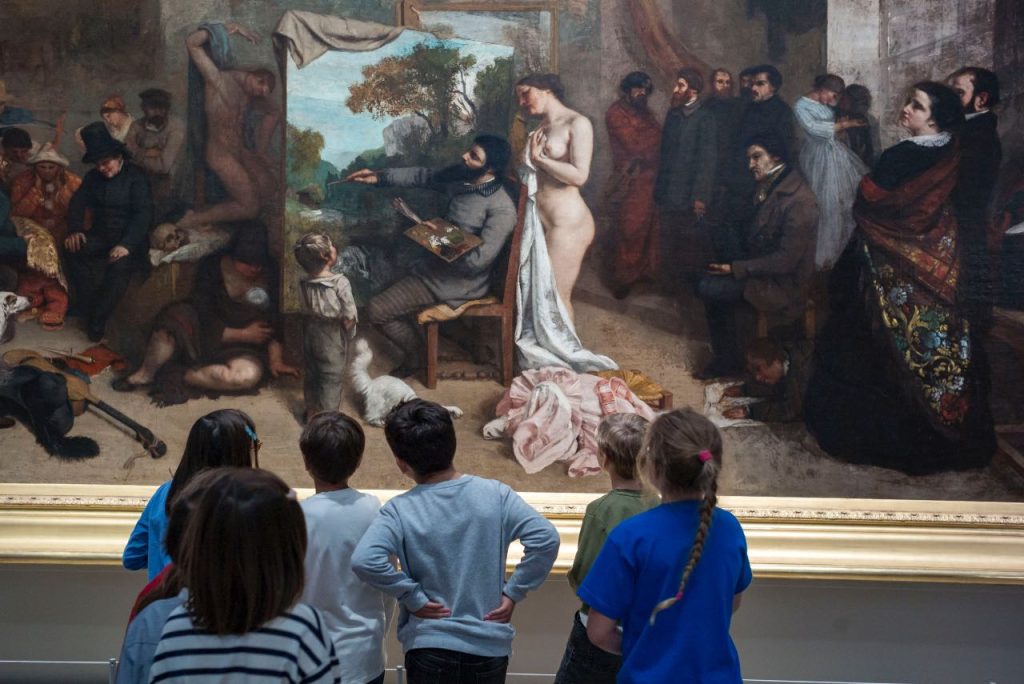As more and more families travel to Paris, it’s increasingly important to understand how to engage children with art in a meaningful way. The city’s rich cultural history and iconic museums offer a wealth of opportunity, but knowing how to speak to young minds about art can make all the difference in enhancing their experience and helping them form a deeper connection to the world around them.

After studying French art history in Paris, I returned to my hometown, where the director of a local museum invited me to serve as a docent for a special exhibit on French Impressionist artists, featuring rare works from the Musée d’Orsay. Excited to share my passion for art, I guided several school groups, many of whom were experiencing Monet, Seurat, and Cassatt for the first time.
What I hadn’t anticipated was how uniquely different it would be to communicate the stories and emotions behind the artwork to children compared to adults. It quickly became clear that speaking to children about art requires a different approach—one that’s more interactive, imaginative, and full of wonder. I’m delighted to share some of the surprising insights I gained from those moments and how they changed the way I see art and the process of teaching.
Encourage Observation │ Begin by inviting children to observe what they see. Encouraging them to describe what the scene, the characters, and other interesting elements. Doing so helps them engage actively with the artwork and builds their observational skills. Ask open-ended questions like:
- “What do you notice first when you look at this painting?”
- “What colors do you see?”
- “What do you think is happening in this picture?”
Explore Emotions and Reactions │ Art often evokes emotions. By validating emotional responses, you encourage empathy and a deeper connection to the artwork. Help children identify their feelings and reactions to the artwork:
- “How does this painting make you feel?”
- “Does this remind you of anything?”
- “What do you think the artist was feeling when they made this?”
Discuss Storytelling │Many pieces of art tell stories or convey messages. Try to fosters imagination and critical thinking skills, allowing children to see art as a way to tell stories and explore different perspectives. Encourage them to create their own narratives around what they see:
- “What do you think is happening in this scene?”
- “What do you think might happen next?”
Visit Museums and Art Exhibitions │Take children to museums, galleries, or exhibitions to expose them to a variety of art forms and styles. Share interesting facts about the artists and artwork to enrich their understanding and appreciation.
Be Supportive and Non-Judgmental │Encourage children to express their thoughts, opinions, and interpretations without fear of being wrong. Art is subjective, and there are no “right” or “wrong” answers when it comes to how we experience or interpret art.
Make It a Conversation, Not a Lecture │Instead of simply lecturing, make the experience a dialogue. Ask for their thoughts, listen attentively to what they have to say, and explore their ideas together.
Use Age-Appropriate Language │ Tailor your language to suit the child’s age and level of understanding. Avoid using complex art terminology unless the child is already familiar with it. Keep things simple, clear, and fun! This is so important. I found myself using terms such as iridescent and then quickly correcting myself.
Celebrate Their Curiosity │Lastly, celebrate and nurture their curiosity about art. Encourage them to ask questions and explore aspects of art that spark their imagination. The more they feel empowered to ask and discover, the more they’ll appreciate art as a lifelong pursuit.
By fostering a supportive and explorative environment, you can help children develop a lifelong appreciation for art. This process not only enhances their creativity but also nurtures their critical thinking and emotional intelligence. Talking about art with children isn’t just about teaching them about paintings or sculptures; it’s about encouraging a deeper understanding of the world around them and empowering them to express themselves freely and confidently.
Through June 15, the Musee d’Orsay is hosting a series of family days dedicated to children ages 6-12. You can learn more about reserved hours and special programming on the website.
Bonne visite!



Very interesting advice.
Thank you Jeannine
This is so precious
It is really interesting not only for kids but for adults too.. definitely for me